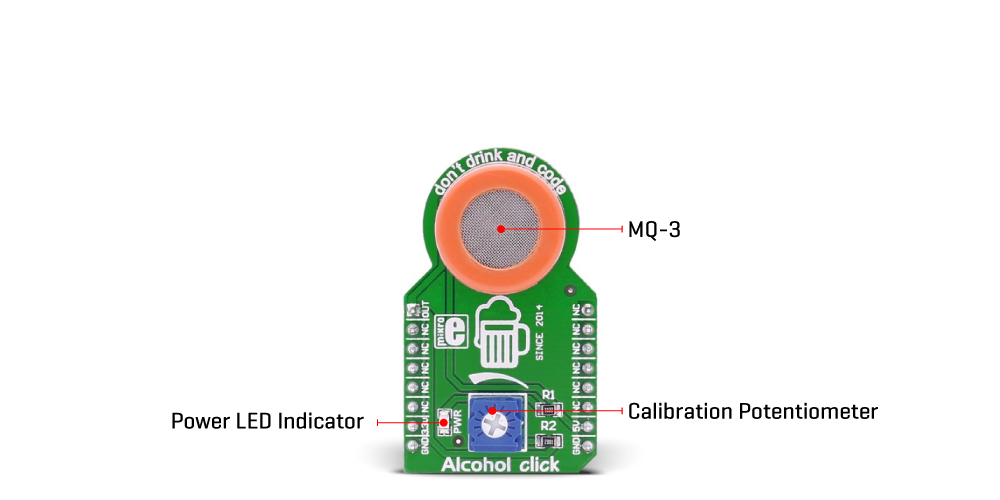OFF
GO LOCAL
| Company | Stock | Price |
|---|---|---|

MIKROE-1586
33 g
Status:
Alcohol Click is a compact add-on board that can detect the presence of alcohol gases. This board features MQ-3, an alcohol gas sensor from Zhengzhou Winsen Electronics Technology. The gas sensing layer on the MQ-3 sensor unit is made of Tin dioxide (SnO2), an inorganic compound with lower conductivity in clean air (the conductivity increases as the levels of alcohol gas rise). It has a high sensitivity to alcohol and can be used to detect alcohol in concentrations from 0.04 to 4mg/l communication with the host MCU through the analog mikroBUS™ line. This Click board™ is suitable for alcohol checking applications or as a “breathalyzer”.
Alcohol Click is supported by a mikroSDK compliant library, which includes functions that simplify software development. This Click board™ comes as a fully tested product, ready to be used on a system equipped with the mikroBUS™ socket.
This product is no longer in stock
Availability date:
OFF
| Company | Stock | Price |
|---|---|---|

Alcohol Click is based on the MQ-3, an alcohol sensor module from Zhengzhou Winsen Electronics Technology, which detects the presence and the concentration of alcohol in the air. The MQ-3 gas sensor comprises a micro AL2O3 ceramic tube, a Tin Dioxide (SnO2) sensitive layer, a measuring electrode, and a heater fixed into a crust made of plastic and stainless steel net. The heater provides necessary work conditions for the work of sensitive components. It has a high sensitivity to alcohol and slight to benzine, suitable for detecting alcohol in concentrations from 0.04 to 4mg/l.

The MQ-3 provides an analog representation of its concentration in the air sent directly to an analog pin of the mikroBUS™ socket labeled OUT. The analog output voltage provided by the sensor varies in proportion to the alcohol concentration; the higher the alcohol concentration in the air, the higher the output voltage. Also, this Click board™ has a built-in potentiometer that allows users to adjust the Load Resistance of the MQ-3 circuit for optimum performance.
This Click board™ can be operated only with a 5V logic voltage level. The board must perform appropriate logic voltage level conversion before using MCUs with different logic levels. However, the Click board™ comes equipped with a library containing functions and an example code that can be used, as a reference, for further development.
Type
Alcohol,Gas
Applications
Can be used for alcohol checking applications or as a “breathalyzer”
On-board modules
MQ-3 - alcohol sensor module from Zhengzhou Winsen Electronics Technology
Key Features
Low power consumption, high sensitivity to alcohol and small to benzine, fast response, stable and long life, simple drive circuit, sensitivity adjustment, and more
Interface
Analog
Feature
No ClickID
Compatibility
mikroBUS™
Click board size
M (42.9 x 25.4 mm)
Input Voltage
3.3V
This table shows how the pinout on Alcohol Click corresponds to the pinout on the mikroBUS™ socket (the latter shown in the two middle columns).
| Label | Name | Default | Description |
|---|---|---|---|
| LD1 | PWR | - | Power LED Indicator |
| P1 | - | Populated | Calibration Potentiometer |
| Description | Min | Typ | Max | Unit |
|---|---|---|---|---|
| Supply Voltage | - | 5 | - | V |
| Detection Range | 0.04 | - | 4 | mg/l |
We provide a library for the Alcohol Click as well as a demo application (example), developed using MIKROE compilers. The demo can run on all the main MIKROE development boards.
Package can be downloaded/installed directly from NECTO Studio Package Manager (recommended), downloaded from our LibStock™ or found on MIKROE github account.
Library Description
This library contains API for Alcohol Click driver.
Key functions
alcohol_read_an_pin_value This function reads results of AD conversion of the AN pin.
alcohol_read_an_pin_voltage This function reads results of AD conversion of the AN pin and converts them to proportional voltage level.
Example Description
The demo application shows the reading of the adc values given by the sensors.
void application_task ( void ) {
uint16_t alcohol_an_value = 0;
if ( alcohol_read_an_pin_value ( &alcohol, &alcohol_an_value ) != ADC_ERROR ) {
log_printf( &logger, " ADC Value : %urn", alcohol_an_value );
}
float alcohol_an_voltage = 0;
if ( alcohol_read_an_pin_voltage ( &alcohol, &alcohol_an_voltage ) != ADC_ERROR ) {
log_printf( &logger, " AN Voltage : %.3f[V]rnn", alcohol_an_voltage );
}
Delay_ms( 1000 );
}
The full application code, and ready to use projects can be installed directly from NECTO Studio Package Manager (recommended), downloaded from our LibStock™ or found on MIKROE github account.
Other MIKROE Libraries used in the example:
Additional notes and informations
Depending on the development board you are using, you may need USB UART click, USB UART 2 Click or RS232 Click to connect to your PC, for development systems with no UART to USB interface available on the board. UART terminal is available in all MIKROE compilers.
This Click board™ is supported with mikroSDK - MIKROE Software Development Kit. To ensure proper operation of mikroSDK compliant Click board™ demo applications, mikroSDK should be downloaded from the LibStock and installed for the compiler you are using.
For more information about mikroSDK, visit the official page.
NOTE: Please be advised that any peripheral devices or accessories shown connected to the Click board™ are not included in the package. Check their availability in our shop or in the YMAN section below.